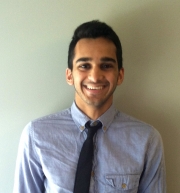Posted on August 18, 2014
Source: Neel Sangal, Baltiomore HIV Scholar

Hi! My name is Neel Sangal, a soon to be senior at Johns Hopkins. This summer I have been working in the infectious disease (ID) laboratory of the medical school under the direction of Dr. Michael Chattergoon. The lab has been extremely open and welcoming and really has made me feel like part of a team, working to discover the intricacies of the mechanism of viral infection. Specifically my project over the summer has focused on understanding the role of the inflammasome complex activation in the replication of HIV in cells. Understanding this will help us to develop approaches to eradicate latent reservoirs of virus post HAART treatment.
I start work in the lab by meeting with Dr. Chattergoon, discussing plans for the day and updating each other on new findings from the lab and in the literature. I have been working on a few projects simultaneously and have also been trying to learn new lab techniques from other members of the lab. On Tuesdays, we have a whole group lab meeting featuring a member of the lab presenting their research and lots of pizza!
A bit of specific science information regarding my projects:
My primary project involves studying the effects of various cytokines on HIV replication. We get fresh blood from leukopacks from which we isolate leukocytes which are then frozen for future use. I take these cells and separate the t-cells out, stimulating them. I then take virus and use a process called spinoculation to infect the t-cells with HIV. I then add the target cytokines to the cell suspension at different concentrations and freeze different timepoints of the mixture (0, 48, 72, 96, 120hrs.). The extent of viral replication at the various timepoints is quantified by a ELISA test which measures the amount of HIV surface protein p24.
My other project involves understanding the role of microRNA-223 (miR-223) in the activation of the inflammasome complex. I basically isolate monocytes through a similar process as with the t-cells but the yield is much lower. I transfect these monocytes with a purchased miR-223 mimic, increasing the concentration of miR-223 in the cells. The cells are then lysed, the RNA is isolated and converted to cDNA for qPCR. qPCR is run on the transfected cells and controls and is quantified based on standard curves.
Working in the ID lab has really opened my eyes to the sheer amount of progress that has been made and all that is still not known. Research this summer has made time fly and I can not believe that my time with the CFAR is almost over, I know that I have enjoyed every second of it. I am very thankful to the CFAR, my mentor Dr. Chattergoon and the ID lab for giving me this wonderful opportunity and making it such a meaningful experience.